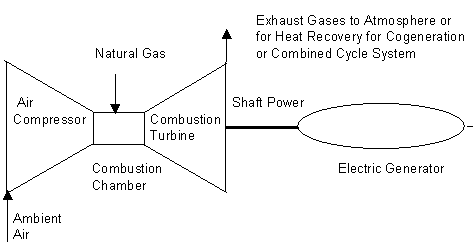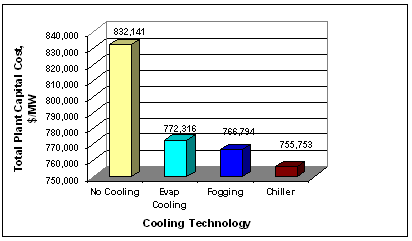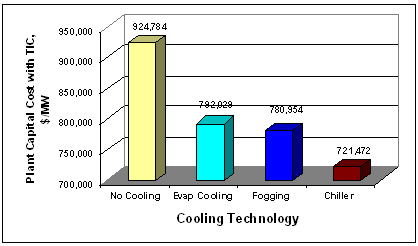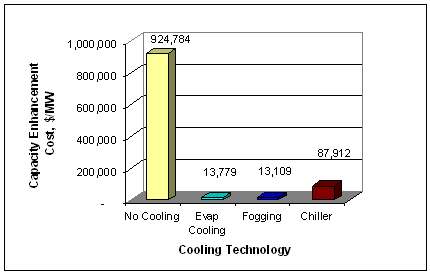INTRODUCTION
This section addresses two of the following frequently asked questions: What is TIC? Why Cool Turbine Inlet Air?What is TIC?
A typical schematic flow diagram of a combustion turbine (CT) system is shown in Figure 1. TIC is cooling of the ambient air before it enters the compressor that supplies high-pressure air to the combustion chamber from which hot air at high pressure enters the combustion turbine. TIC is also called by many other names, including combustion turbine inlet air cooling (CTIAC), turbine inlet air cooling (TIAC), combustion turbine air cooling (CTAC), and gas turbine inlet air cooling (GTIAC).

Figure 1. Schematic Diagram of a Typical CT System
Why Cool Turbine Inlet Air?
The primary reason turbine inlet air is cooled is to reduce or prevent the often significant loss of power output, compared to the rated capacity, of combustion turbines when ambient air temperature is high. TIC can even help to enhance CT output above its rated capacity. TIC is applicable to all combustion turbines (CTs), whether operating in simple-cycle, cogeneration, and combined-cycle systems.
The rated capacities of all CTs are based on the standard ambient air conditions of 59oF and 14.7 psia at sea level, as selected by the International Standards Organization (ISO). One unattractive characteristic of all CTs is that their power output decreases as the inlet air temperature increases as shown in Figure 2.

Figure 2. Effect of Ambient Temperature on the Output of CTs
It shows the effects of inlet air temperature on power output for two types of CTs: Aeroderivative and Industrial/Frame. The data in Figure 2 are typical for the two types of turbines. The actual characteristics of each CT could be different depending on its actual design.
The data in Figure 2 show that for a typical aeroderivative CT, an increase in inlet air temperature from 59oF to 100oF on a hot summer day, decreases power output to about 73% of its rated capacity. This could lead to a loss of opportunity for power producers to sell more power just when the rise in ambient temperature increases power demand for operating air conditioners.
By cooling the inlet air from 100oF to 59oF, we could prevent the loss of 27% of the rated generation capacity. In fact, if we cool the inlet air to about 42oF, we could enhance the power generation capacity of the CT to 110% of the rated capacity. Therefore, if we cool the inlet air from 100oF to 42oF, we could increase power output of an aeroderivative CT from 73% to 110% of the rated capacity or boost the output capacity by about 50% of that at 100oF.
How Does TIC Help Increase CT Output?
Power output of a CT is directly proportional to and limited by the mass flow rate of compressed air available to it from the air compressor that provides high-pressure air to the combustion chamber of the CT system. An air compressor has a fixed capacity for handling a volumetric flow rate of air for a given rotational speed of the compressor. Even though the volumetric capacity of a compressor is fixed, the mass flow rate of air it delivers to the CT changes with fluctuations in ambient air temperature. This mass flow rate of air decreases with an increase in ambient temperature because the air density decreases when air temperature increases. Therefore, the power output of a combustion turbine decreases below its rated capacity at the ISO conditions (59oF and 14.7 psia at sea level) with increases in ambient temperature above 59oF. TIC allows an increase in air density by lowering the temperature, and thus, helps increase the mass flow rate of air to the CT and results in increased output of the CT.
BENEFITS
A substantial number of new power plants in the world would not need to be built if TIC is used to utilize the hidden capacity of existing combustion turbine plants. TIC provides economic and environmental benefits. These benefits are good for the combustion turbine plant owners, the ratepayers and the general public. A brief qualitative list of TIC benefits is available.
The overall economic benefit of TIC is that it helps optimize CT assets in new or existing simple-cycle, cogeneration and combined-cycle systems. When ambient temperature is above 59oF, some specific benefits of TIC include the following:
- Increased power output
- Reduced capital cost ($/kW) per unit of power plant output capacity
- Increased fuel efficiency
- Increased steam output in cogeneration systems
- Increased power output of steam turbines in combined-cycle systems
- Improved predictability of power output by eliminating the weather variable.
Increased Power Output
The primary benefit of TIC is that it allows the plant owners to reduce or prevent loss of CT power output, compared to the rated capacity, when ambient temperature rises above 59oF or if the plant is located in a warm/hot climate region. TIC can even allow the plant owners to increase the CT output above the rated capacity by cooling the inlet air to below 59oF as shown in Figure 1.

Figure 1. Effect of Ambient Temperature on the Output of CTs
Reduced Capital Cost Per Unit of Power Plant Output Capacity
If a power producer does not apply TIC but wants or needs to make up for the lost capacity due to an increase in ambient temperature, its only option is to incur the capital cost of installing another CT (or another type of generator) and bringing it online to make up for the lost capacity. As discussed later in this section, the option of installing another CT (as a peaking turbine) is usually more expensive than using TIC for the baseline CT system.
Increased Fuel Efficiency
A significant secondary benefit of TIC is that it also reduces or prevents a decrease in fuel efficiency (increase in heat rate) of the CT, compared to the design efficiency/heat rate, due to increase in ambient temperature above 59oF. Figure 2 shows the effect of inlet air temperature on heat rate (fuel required per unit of electric energy) for the two types of CTs discussed in the earlier section.

Figure 2. Effect of Ambient Temperature on CT Heat Rate
It shows that for an aeroderivative CT an increase in inlet air
temperature from 59oF to 100oF increases heat rate (and thus, decreases fuel efficiency) by 4% (from 100% at 59oF to 104% at 100oF). TIC could even help increase fuel efficiency (decrease heat rate), compared to the design efficiency/heat rate, by cooling the inlet air to below 59oF. For example, for a typical aeroderivative CT in Figure 2, cooling the inlet air from 59oF to 42oF reduces the heat rate (increases fuel efficiency) by about 2% (from 100%to about 98%).
Increased Steam Output in Cogeneration and Power Output of Steam Turbine Output in Combined-Cycle Systems
TIC not only reduces or prevents loss of CT power output; it also reduces or prevents loss of steam produced in cogeneration systems and loss of power output of steam turbines in combined-cycle systems when ambient air temperature increases above 59oF. As discussed earlier, the power output of a CT decreases with an increase in ambient temperature because the mass flow rate of inlet air decreases. This decreased mass flow rate also results in decreased total energy in the CT exhaust gases which in turn leads to reduced steam production in the heat recovery steam generators (HRSG). The reduced steam generation in the HRSG results in lower output of steam turbines in combined-cycle systems.
Improved predictability of power output by eliminating the weather variable
Some of the TIC technologies (discussed later) allow CT operations at any desired temperature, as low as 42oF, independent of the weather conditions. Therefore, these technologies facilitate predictable power output at all times and eliminate weather as a variable in predicting power output of power plants using CTs.
Technology Overview
TECHNOLOGIES
Many technologies are commercially available for TIC. These technologies can be divided into the following major categories/groups:
- Evaporative: wetted media, fogging, and wet compression
- Chillers: mechanical and absorption chillers without or with thermal energy storage (TES)
- LNG Vaporization
- Hybrid Systems: combinations of several technologies
All of the technologies listed above have inherent advantages and limitations. Many published articles are available on these technologies. A number of these publications are listed in the Library section.
Wetted media is one of the evaporative cooling technologies in which cooling is achieved by evaporation of the water added to the CT inlet air. Historically, it is the first technology to be used for TIC. In this technology, the inlet air is exposed to a film of water in one of the many types of wetted media. A honey-comb-like medium is one of the most commonly employed media. Wetted media can cool the inlet air from the ambient dry-bulb temperature by 85% to 95% of the difference between the ambient dry-bulb and wet-bulb temperature. It is one of the lowest capital and operating cost options. The extent of cooling is limited by the wet-bulb temperature. It works most efficiently during hot and dry weather and is less effective when ambient humidity is high. On an overall basis, this is the most widely used technology.
Fogging is another evaporative cooling technology. The basic idea in this technology is to add water to the inlet air by spraying very fine droplets of water. Fogging systems can be designed to produce droplets of variable sizes, depending on the desired evaporation time and ambient conditions. The water droplet size is generally less than 40 microns and on an average it is about 20 microns. The water used for fogging typically requires demineralization. Fogging systems can cool the inlet air by 95% to 99% of the difference between ambient dry-bulb and wet-bulb temperature. Its capital cost is very comparable to that for the wetted media. It is the second most frequently applied technology for TIC.
Wet Compression is yet another evaporative cooling technology in which more fog is added to the inlet air than can be evaporated under the conditions of the ambient air. The air stream carries the excess fog into the compressor section of the CT where it further evaporates, cools the compressed air and creates extra mass for boosting the CT output beyond that possible with the evaporative cooling technologies. The cooling of the compressor section reduces work in the compressor section, allowing increased power available from the system. Wet compression also leads to additional power augmentation due to the increased mass flow of the water and fuel in the system in order to maintain constant firing temperature. Wet compression is a complementary technology and can provide added benefit to any other TIC technology.
Mechanical Chiller systems cancool the inlet air to lower than wet bulb temperature and when properly designed can maintain any desired inlet air temperature down to as low as 42oF, independent of ambient wet-bulb temperature. The mechanical chillers used in these systems could be driven by electric motors, steam turbines or engines. Drawing the inlet air across cooling coils, in which either chilled fluid or refrigerant is circulated, cools it to the desired temperature. Mechanical chiller-based TIC systems are more capital intensive than evaporative systems and when using electric motors, these systems also have the highest parasitic loads. The chilled water can be supplied directly from a chiller or from a TES (Thermal Energy Storage) tank that stores ice, or chilled fluid. A TES system is typically used when there are only a limited number of hours per day when inlet air cooling is needed. TES can reduce overall capital costs because it reduces the chiller capacity requirements as compared to the capacity required to match the instantaneous on peak demand for cooling. Since the chillers in TES systems are operated during the off-peak period using low-cost electricity for charging the TES tank, such a system increases the net power capacity during the on-peak period.
Absorption Cooling systems are similar to the mechanical refrigeration systems except that instead of using mechanical chillers, these systems use absorption chillers that require thermal energy (steam or hot water) as the primary source of energy and require much less electric energy than the mechanical chillers. Absorption cooling systems can be used to cool the inlet air to about 50oF. These systems can be employed with or without chilled water TES systems. Absorption chillers can be single-effect or double-effect chillers. The single-effect absorption chillers use hot water or 15-psig steam (18 lb./RT-hr) while the double-effect chillers require less steam (10 lb./RT-hr) but need the steam at higher pressure (115 psig). Compared to mechanical chillers, absorption cooling systems have lower parasitic loads but higher capital costs. The primary successful applications of Absorption chillers in power plants are where excess thermal energy is available and the conversion of this energy to high-value electric energy creates a winning situation for the user.
LNG Vaporization systems are useful for power plants located near a liquefied natural gas (LNG) import or storage facility. In supplying natural gas for power plant or other applications, LNG must be vaporized by some heat source. For applications in TIC, the inlet air is used as such a heat source.
Hybrid Systems incorporate some combination of two or more technologies, such as mechanical and absorption chillers, evaporative and chilling, and fogging or chilling with wet compression. The objective of hybrid systems is to maximize net power output during hot weather. Each hybrid system needs to be optimized for a specific plant based on the weather data, power demand and electric prices and availability of thermal energy.
Technology Overview
ECONOMICS
The economics of TIC is discussed using the examples of two cogeneration plants located in Los Angeles, CA. One plant deploys an industrial/frame CT of 83.5 MW capacity and the other uses an aeroderivative CT of 42 MW capacity.
When the ambient temperature in Los Angeles is 87oF dry-bulb and coincident wet-bulb temperature is 64oF the output of the uncooled 83.5 MW and 42 MW cogeneration plants drops to about 75.3 MW and 32.1 MW, respectively. Compared to the rated capacities of the two plants, the reduced outputs represent loss of capacity by about 10% and 24%, respectively.
The technical and economic impacts of using TIC for the above two types of plants are discussed for three cooling technologies: Wetted Media (Evap Cooling), Fogging and Electric Chillers. As pointed out earlier in the discussion on technologies, the results of various TIC technologies depend on the weather (dry-bulb and wet-bulb temperatures) for the plant location.
Output Enhancement
Assuming a 90% and 98% approach to the difference between the dry-bulb and wet-bulb temperatures for the wetted media (evaporative cooling) and fogging technologies, these two technologies can cool the inlet air to 66.3oF and 64.5oF respectively. Assuming that the electric chiller system is designed for cooling the inlet air to 45oF, such a system requires total cooling capacities of 2,330 RT and 1200 RT for the 83.5 MW and 42 MW CTs, respectively. Assuming a typical electric chiller power requirement of 0.65kW/RT and an additional 0.16kW/RT for chilled water, condenser water and cooling tower pumps the total parasitic power needs for the chiller capacities are 1.9 MW and 0.96 MW for the larger and the smaller CTs, respectively. Comparisons of various TIC technologies with the uncooled CT in terms of total power plant output are shown in 1 and Figures 4 and 5.

Figure 4. Effect of TIC Technology on Net Power Output of the 83.5 MW CT
The results in Figure 4 show that evaporative cooling and fogging can enhance the capacities of the larger uncooled system (75.3 MW) to 81.3 MW and 81.9 MW, respectively. Therefore, these TIC technologies can restore most of the 10% lost capacity to within 3% of the rated capacity.
The results for the aeroderivative CT, shown in Figure 5, are similar but more pronounced than those for the industrial/frame CT. The capacity of this uncooled system goes up from 34.1 MW to 39.9 MW and 40.4 MW by the evaporative cooling and fogging technologies, respectively and thus, restores most of the 24% lost capacity to within 4% of the rated capacity.

Figure 5. Effect of TIC Technology on Net Power Output of the 42 MW CT
Even though the results of using evaporative cooling and fogging are very good, these technologies are not able to achieve the full-rated capacities. In addition, the extent of cooling achieved by these technologies depends on the ambient wet-bulb temperature. If the wet-bulb temperature goes up (i.e. outside humidity increases) their effectiveness decreases. Therefore, the results of these technologies for this plant in Houston, TX will be less impressive because of typically higher ambient humidity than that in Los Angeles, CA or Las Vegas, NV.
The results in Figures 4 and 5 show that the electric chiller system yields maximum power capacity enhancement even after accounting for the large parasitic needs of the chiller system. The chiller system in this example is designed to cool the inlet air to 45oF and is able to achieve output capacities that exceed the rated capacities. Another advantage of the chiller system is that it can be designed to achieve almost constant output independent of the ambient dry- and wet-bulb temperatures. Of course, the chiller system costs more to install than the evaporative cooling and fogging systems.
Economic Benefits
The economic benefits of the three TIC technologies, discussed above, on the installed cost for the total plant capacity for the two types of CTs are shown in Figures 6 through 9. The basis for the installed costs shown in these figures are as follows:
Cogeneration CT Plant: $750,000/MW
(No Cooling)
Wetted Media (Evap Cooling): $19,000/MW CT capacity at ISO
Fogging: $19,000/MW CT capacity at ISO
Electric Chiller: $800/RT

Figure 6. Effect of TIC Technology on Total Plant Investment for the 83.5 MW CT

Figure 7. Effect of TIC Technology on Total Plant Investment for the 42 MW CT
The results in the above Figures show that the total plant capital cost, expressed as $/MW, is lower for the plants with TIC than those for the uncooled systems.
The plant owners have only two options for increasing plants output capacity: add another CT (or another generator) or install TIC for the existing CT. The economic benefits of TIC become significantly more apparent when we compare the capital costs per unit of output enhancement as shown in Figures 8 and 9.

Figure 8. Effect of TIC Technology on Incremental Cost for Capacity Enhancement for the 83.5 MW CT

Figure 9. Effect of TIC Technology on Incremental Cost for Capacity Enhancement the 42 MW CT
The results in these figures show that for the incremental capital cost for enhancing plant capacity by one MW is significantly lower for TIC technologies than installing another uncooled CT.
As pointed out earlier, the results of various TIC technologies depend on the plant location. Therefore, the economics of these technologies would be different for the plants located in Houston, TX and Las Vegas, NV from those discussed above for the Los Angeles, CA location.
Selecting Optimum Technology
As stated earlier, all of the above discussions relate to a situation when the ambient dry-bulb and wet-bulb temperatures are 87oF and 64oF, respectively. However, this information is not sufficient to decide whether TIC is economically attractive and if so which cooling technology will be economically most attractive. Such estimates require calculations using hourly weather data for 8,760 hours of the year and also require information for cost of fuel, power demand profile and market value of power produced (which may vary with the time of day).
Many power plants across the U.S. are using various TIC technologies that best suit their needs. A database of some of these installations is available in the Experience Database section.